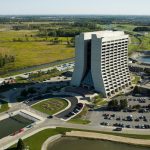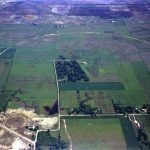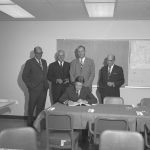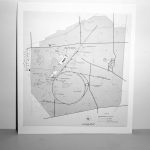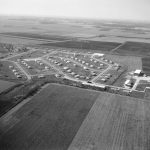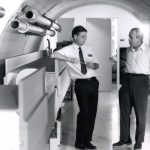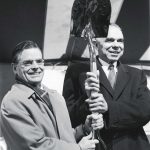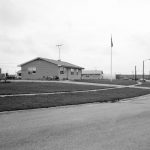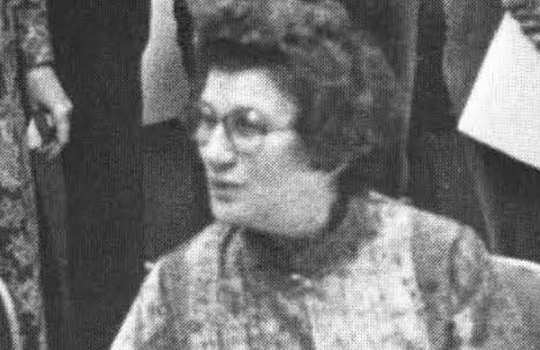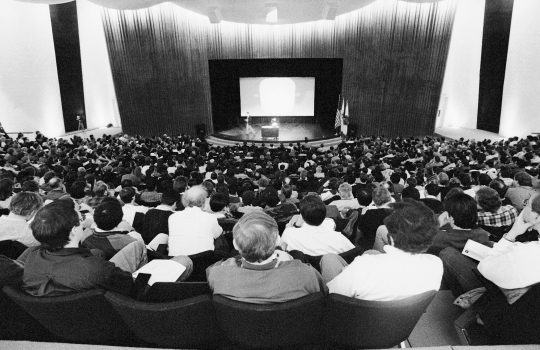Editor’s note: Learn about the laboratory’s birthday events, view a historical timeline and see photographs taken throughout the laboratory’s 50th year on the Fermilab 50th anniversary website.
Fermilab is turning 50! So how did it all start?
Fermilab — originally called the National Accelerator Laboratory — began operations in Illinois on June 15, 1967. The lab was built on 6,800 acres of land near the town of Batavia, Illinois, on a site that included the buildings of a small housing development named Weston. Fermilab’s first big machine, a particle accelerator about four miles in circumference called the Main Ring, paved the way to the construction of the world’s most powerful particle collider, the Tevatron. The original Main Ring was designed to collide particles at what was then a staggering 200 billion electronvolts of energy. The possibility of achieving that high energy was the driving reason for creating the National Accelerator Laboratory.
Today Fermilab is one of 17 national laboratories of the U.S. Department of Energy. It is America’s premier laboratory for particle physics research and houses seven particle accelerators that provide beam for numerous experiments and R&D projects. It is the future home of the Long-Baseline Neutrino Facility, which will power the world’s biggest neutrino experiment, the Deep Underground Neutrino Experiment.
“While Fermilab and the field of high-energy physics have changed and evolved since its 1967 founding, the dedication and imagination of the staff and the user community in answering ever deeper and broader questions have remained as strong as ever,” said Adrienne Kolb, who served as Fermilab archivist and historian from 1983 to 2015.
On June 15, 1967, Robert Wilson and 17 other employees of NAL, AEC and DUSAF (the architectural and engineering firm responsible for much of the early construction at Fermilab) began their work in Illinois, the date that Wilson later considered to be laboratory’s birthday. While the Weston houses were prepared for hosting offices and work space for the new lab, Wilson and his team rented offices on the 10th floor of the Oak Brook Executive Plaza tower in Oak Brook, Illinois.
“The first year was very colored by that — that office building was the lab, the place that we went to every day to do what we were doing,” said Lincoln Read, a physicist who worked at the laboratory from 1967 to 2004.
The building was selected for its convenient location between Weston and O’Hare International Airport and gave these pioneers an unobstructed view of the Illinois farmland west of Oak Brook.
In January 1968, the NAL staff finished a new design report partially based on the Berkeley design study that laid out the plan for the laboratory. They moved to the Weston site during September 1968, and the lab broke ground for its first accelerator on Dec. 1, 1968.
“As a small but growing staff, together we all put together a concept design of the facilities and its accelerators,” Read said. “We knew the work we were doing was important, and that became part of the spirit of the place.”
In early 1971, Wilson told the laboratory’s Users’ Organization that “one of the first aims of experiments on the NAL accelerator system will be the detection of a neutrino. I feel that we then will be in business to do experiments on our accelerator.” Later that year experiment E-21, named “Neutrino Physics at Very High Energies” and run by a Caltech group, was the first to detect neutrinos at the new laboratory.
The centerpiece of the emerging accelerator complex was called the Main Ring. The machine reached scientists’ energy goal — 200-billion-electronvolt particle beams — in 1972, four years after completing the accelerator’s design. Thanks to several technological breakthroughs, the laboratory was able to make upgrades and continually increase the beam energy, achieving world record collision energies of nearly 2 trillion electronvolts, or TeV, in 1986. The TeV energy range gave the accelerator in the Main Ring tunnel its new name: the Tevatron.
Today, Fermilab is known for its world-leading accelerator-based neutrino research program, the development and construction of particle accelerators, its contributions to research at the Large Hadron Collider and its particle astrophysics program.
“The quest to understand the universe goes on and beckons us as Fermilab celebrates this 50th anniversary milestone,” Kolb said.
Fermilab now employs about 1,800 employees and represents the second-largest particle accelerator laboratory in the world. Approximately 4,000 scientists from 44 countries use Fermilab and its particle accelerators, detectors and computers for their research. They contribute to the lab’s numerous physics experiments, keeping the United States at the leading edge of the international field of particle physics.


